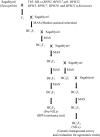Development and characterization of near-isogenic lines for brown planthopper resistance genes in the genetic background of japonica rice 'Sagabiyori'
- PMID: 38106508
- PMCID: PMC10722098
- DOI: 10.1270/jsbbs.23017
Development and characterization of near-isogenic lines for brown planthopper resistance genes in the genetic background of japonica rice 'Sagabiyori'
Abstract
The brown planthopper (BPH: Nilaparvata lugens Stål) is one of the most destructive insects in rice production. The use of host plant resistance has potential to reduce damage caused by BPH. The heat tolerance japonica rice 'Sagabiyori', with superior grain quality and high soluble starch in the stem, is highly susceptible to damage by BPH. Here, to enhance its BPH resistance, we developed seven near-isogenic lines (NILs) carrying BPH2, BPH17-ptb, BPH32, BPH3, BPH17, BPH20, and BPH21 through marker-assisted selection and evaluated resistance to two BPH populations. Most lines were more resistant to the Hadano-1966 BPH population than Sagabiyori but were less effective against the highly virulent Koshi-2013 population. Nevertheless, in antixenosis tests, Koshi-2013 settled less on all NILs than on Sagabiyori. In addition, adult mortality and the percentage of fresh weight loss of lines carrying BPH17 and BPH3 indicated that these lines have higher resistance to Koshi-2013 than Sagabiyori. Current study revealed that BPH resistance of Sagabiyori became stronger by transferring BPH3 and BPH17 genes. Thus, BPH3 and BPH17 might be valuable for breeding programs to enhance BPH resistance of high grain quality rice varieties with heat tolerance.
Keywords: BPH resistance gene; NILs; Nilaparvata lugens; marker-assisted selection.
Copyright © 2023 by JAPANESE SOCIETY OF BREEDING.
Figures






References
-
- Angeles, E.R., G.S. Khush and E.A. Heinrichs (1986) Inheritance of resistance to planthoppers and leafhoppers in rice. In: Rice Genetics, Proceedings of the International Rice Genetics Symposium, International Rice Research Institute, Manila, pp. 537–549.
-
- Bottrell, D.G. and Schoenly K.G. (2012) Resurrecting the ghost of green revolutions past: The brown planthopper as a recurring threat to high-yielding rice production in tropical Asia. J Asia Pac Entomol 15: 122–140.
-
- Brar, D.S., P.S. Virk, K.K. Jena and G.S. Khush (2009) Breeding for resistance to planthoppers in rice. In: Heong, K.L. and B. Hardy (eds.) Planthopper: new threats to the sustainability of intensive rice production systems in Asia, International Rice Research Institute, Los Baños, pp. 401–427.
-
- Claridge, M.F. and Den Hollander J. (1982) Virulence to rice cultivars and selection for virulence in populations of the brown planthopper Nilaparvata lugens. Entomol Exp Appl 32: 213–221.
-
- Dellaporta, S.L., Wood J. and Hicks J.B. (1983) A plant DNA minipreparation: Version II. Plant Mol Biol Report 1: 19–21.

